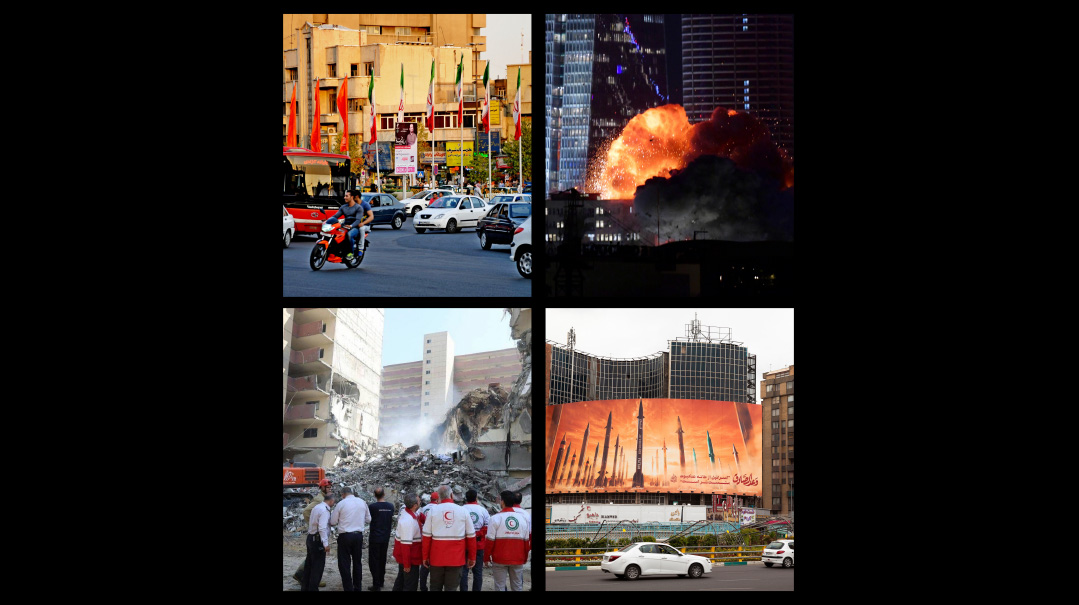Behind the Iran Curtain
| June 24, 2025Fear, futility, and the high price of protest

Photos: AP Images
The civilized world may finally be starting to catch on that the Islamic Republic of Iran is every bit as evil and oppressive as the other regimes that have come after the Jews down through the millennia.
But we are cautioned that, unlike Pharaoh, Titus, and Hitler did, the mullahs in Tehran do not enjoy the support of their populace in their obsession to destroy the State of Israel. If anything, we are told, the leaders are more frightened of their people than they are of the Jews. And the Iranian people, we are told, hate their rulers far more than they hate us.
Is that true? If so, where is the popular uprising to overthrow the ayatollahs? And if there were one, who would take over?
It is notoriously difficult to get accurate information out of the Shia dictatorship, and even more so in wartime. I made the rounds in Washington, D.C., of various Iranian expat organizations opposed to the mullahs to try to get a read on the situation. They can hardly be described as impartial observers — many of them, or their parents, had to flee Iran because they resisted the regime’s rule. Also, some of them have been out of immediate touch with local sentiment in Iran for years — even decades.
But they do bring an intimate understanding of the depths of cruelty exerted by the heirs of Ruhollah Khomeini, an understanding that can help shed light on our present predicament. It all amounts to a terror campaign conducted by the Islamic Republic against its own population: brutal internal security forces, communications blackouts, economic disruptions, and fingering scapegoats.
And the one name that keeps coming up, in discussions of a provisional government to replace the mullahs, has a familiar ring: Crown Prince Reza Pahlavi, the son and heir apparent to Mohammad Reza Pahlavi, the Shah ousted by the 1979 Islamic Revolution.
Besieged by Basij
Reports out of Tehran right now describe a city on edge. During the periods between visits by the Israeli Air Force, the streets are eerily quiet — but not calm. Security forces roll in armored convoys. A government-imposed weeklong Internet blackout has slashed connectivity by over 97 percent since June 17. Behind locked windows, Iranians wait. Not in defiance, but in dread.
“We’re already hearing reports of mass presence of security forces on the streets of Tehran,” says Andrew Ghalili, a senior policy official at the National Union for Democracy in Iran, or NUFDI, a Washington-based nonprofit representing the Iranian-American community.
This isn’t the first time the regime appears vulnerable, and memories of the past remain seared into the Iranian psyche. In 1988, thousands vanished in secret executions. In 2009, protests over fraudulent election results triggered the “Green movement,” which seemed on the verge of toppling the regime — until security forces ruthlessly crushed it. In 2019, protests over fuel price increases spread like wildfire, triggering another regime response that killed nearly 1,500. In 2022, more than 550 perished in the Mahsa Amini protests, so named for a young woman arrested for not wearing a hijab who died in custody.
When the regime in Tehran feels cornered, it doesn’t hesitate to unleash one of its most loyal weapons.
The Basij — short for Basij-e Mostaz’afin, or “Mobilization of the Oppressed” — is anything but oppressed. Formed in 1979 at the behest of Ayatollah Khomeini, this volunteer militia answers directly to the Islamic Revolutionary Guard Corps (IRGC) and has become the regime’s go-to enforcers. Think of them as ideological foot soldiers, equal parts morality police and equal part protest suppressors.
Estimates of the size of Basij forces vary widely. The head of the Basij claims more than 23 million members, but other sources put the number of actual armed troops at something like 50,000. The forces are recruited from most heavily Shia sectors of the population. But when the people get especially restive, and the IRGC wants to respond with live fire, it supplements Basij units with imported terrorists — Hezbollah, Hamas, and extremists drawn from Iraq, Afghanistan, and Pakistan, none of whom feel pangs of conscience when gunning down Iranians.
Over the years, they’ve built a reputation for showing up fast and hitting hard. Whether it’s breaking up student demonstrations or chasing down violators of their modesty laws, these militia march in on motorcycles to thump truncheons, blast bullets, and foment fear. The Basij don’t just maintain order, they enforce loyalty. And in moments of national crisis, they’re often the first to flood the streets. Not to protect the people, but to protect the regime from the people.
The Basij militia began appearing prominently in the streets more than a week ago, as Israel intensified airstrikes on regime targets. Internal security responded by mobilizing Basij units across urban areas as well as in provinces with heavy minority population centers, for widespread patrols, establishing checkpoints, and the rounding up of thousands of civilians who’ve garnered regime attention in the past.
Oops! We could not locate your form.







